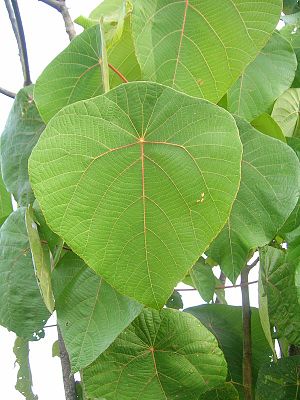Note: This is a project under development. The articles on this wiki are just being initiated and broadly incomplete. You can Help creating new pages.
Macaranga peltata - Uppalige
Uppalige is a very common tree in the evergreen and semi-evergreen forests of the western ghats. They are fast growing trees with large heart shaped leaves. One of the first trees to come up on roadsides and forest clearings.
Contents
- 1 Uses
- 2 Parts Used
- 3 Chemical Composition
- 4 Common names
- 5 Properties
- 6 Habit
- 7 Identification
- 8 List of Ayurvedic medicine in which the herb is used
- 9 Where to get the saplings
- 10 Mode of Propagation
- 11 How to plant/cultivate
- 12 Commonly seen growing in areas
- 13 Photo Gallery
- 14 References
- 15 External Links
Uses
Treat stomach-ache, Dysentery, Haemoptysis, Cough, Fever, Dysuria, Skin problems. [1]
Parts Used
Chemical Composition
It is also useful in coffee plantations for shade. The leaves are rich in nitrogen and potash. They contain water, 60.17; N, 1.3; potassium (KzO), 0.66; and phosphorus (PzOs), 0.18%6. [2]
Common names
| Language | Common name |
|---|---|
| Kannada | batla chandrike, chaandoda, chanda kanne, chandakala, uppalige |
| Hindi | |
| Malayalam | uppila, vatta |
| Tamil | vattakanni, attattamarai |
| Telugu | boddi, godugu ganapa, konda thaamara, kondajaaphara, pulichinjalamu |
| Marathi | NA |
| Gujarathi | NA |
| Punjabi | NA |
| Kashmiri | NA |
| Sanskrit | |
| English |
[3]
Properties
Reference: Dravya - Substance, Rasa - Taste, Guna - Qualities, Veerya - Potency, Vipaka - Post-digesion effect, Karma - Pharmacological activity, Prabhava - Therepeutics.
Dravya
Rasa
Vipaka
Karma
Prabhava
Habit
Identification
Leaf
| Kind | Shape | Feature |
|---|---|---|
| Simple | Alternate | Leaves simple, alternate, 11-25 x 9-20 cm, ovate-orbicular, deltoid-ovate, ovate or orbicular, apex acute or acuminate, base peltate, margin entire, glabrous or glabrescent, pubescent with reddish glands beneath, coriaceous; stipules large, lateral, ovate-acuminate, reflexed, cauducous; petiole 12-35 mm long, stout, glabrous; lamina 8-10 ribs from base, palmate, prominent beneath; lateral nerves 7-8 pairs, parallel, regular, prominent, intercostae scalariform, much prominent; margin glandular. |
Flower
| Type | Size | Color and composition | Stamen | More information |
|---|---|---|---|---|
| Unisexual | Male flowers: in axillary, much branched, dense, tomentose, panicles, concealed in large bracts; bracteoles concave; tepals 3, minute, obovate, cuneate; stamens 2-8, free, shortly connate below, exserted. Female flowers: in panicles simpler than in males, branches racemes with larger bracts; tepals 4, basally connate at base; ovary superior, 2-6-celled, densely glandular, ovule one in each cell; style lateral; stigma sessile, often embracing one side of the ovary, thickly papillose. | {{{3}}} | {{{4}}} | {{{5}}} |
Fruit
| Type | Size | Mass | Appearance | Seeds | More information |
|---|---|---|---|---|---|
| Capsule | 5-6 mm across | Globose, hairy, glandular, black; seed one, black. | {{{5}}} | {{{6}}} |
Other features
List of Ayurvedic medicine in which the herb is used
Where to get the saplings
Mode of Propagation
How to plant/cultivate
Trees produce an abundance of seeds. They need to be scarified before sowing, acid treatment or mechanical scarification can done. [5]
Commonly seen growing in areas
Tropical area, Evergreen forest, Moist deciduous forest.
Photo Gallery
References
External Links
- Ayurvedic Herbs known to be helpful to treat Treat stomach-ache
- Ayurvedic Herbs known to be helpful to treat Dysentery
- Ayurvedic Herbs known to be helpful to treat Haemoptysis
- Ayurvedic Herbs known to be helpful to treat Cough
- Ayurvedic Herbs known to be helpful to treat Fever
- Ayurvedic Herbs known to be helpful to treat Dysuria
- Ayurvedic Herbs known to be helpful to treat Skin problems
- Herbs with Roots used in medicine
- Herbs with Leaves used in medicine
- Herbs with Bark used in medicine
- Herbs with common name in Kannada
- Herbs with common name in Malayalam
- Herbs with common name in Tamil
- Herbs with common name in Telugu
- Habit - Tree
- Herbs that are commonly seen in the region of Tropical area
- Herbs that are commonly seen in the region of Evergreen forest
- Herbs that are commonly seen in the region of Moist deciduous forest
- Herbs
- Plants of western ghats
- Euphorbiaceae






